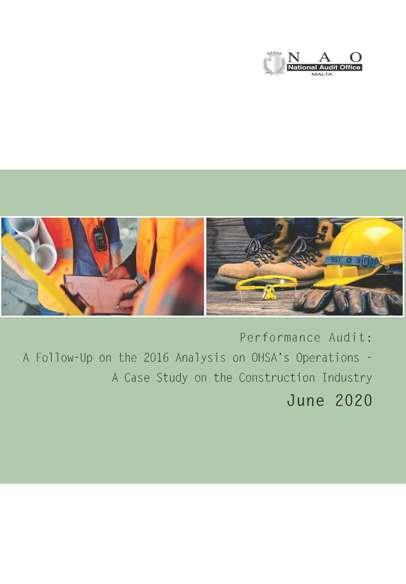- Home
- Publications
Publications
You may browse through our online list of NAO publications which include audit reports and annual reports. The audit reports are categorised according to the Classification of the Functions of Government (COFOG) developed by the OECD.
All Publications- Categories
- Publications Archive
- Events
- Careers
- About Us
 Public Order and Safety June 2020
Public Order and Safety June 2020Performance Audit: A Follow-Up on the 2016 Analysis on OHSA’s Operations – A Case Study on the Construction Industry
Download PublicationPress Release
This follow-up review positively noted that a number of the recommendations put forward by this Office in 2016 have been accepted despite that the degree of implementation varied. NAO highlights that OHSA can make a significant leap in its operations by introducing at the earliest possible a Management Information System.
Auditor General Mr Charles Deguara today presented the performance audit report in caption to the Speaker of the House of Representatives Dr Anglu Farrugia. In 2016, NAO carried out a Performance Audit to assess the efficiency and effectiveness of the Occupational Health and Safety Authority (OHSA) in regulating OHS considerations in the Construction Industry. This follow up was carried out to determine progress, or otherwise, registered by the OHSA in implementing the recommendations set in the 2016 report.
This Office primarily observed that OHSA does not have an adequate Management Information System (MIS) in place and that this is inhibiting the efficiency by which the Authority conducts various elements of its inspectorate function. While NAO understands that the acquisition of a fully-fledged MIS comes at a substantial price tag, it firmly believes that an entity with such a vast an inspectorate remit as that of OHSA simply cannot do away with such a tool to conduct its duties efficiently and effectively.
NAO reiterates its recommendation that the set thresholds for the Authority to be notified of a construction activity should be revisited. Specifically, this Office is of the opinion that these thresholds are set too high when considering the scale of construction projects in Malta. This means that OHSA does not have active visibility on the numerous smaller projects which can still pose significant occupational health and safety (OHS) related risks.
This study also found that, contrary to that proposed in 2016, the legal responsibility of appointing a Project Supervisor (PS) to oversee OHS considerations in a construction project, remains with the client. Seeing that this latter stakeholder may not be fully knowledgeable on OHS requirements, NAO still maintains that the legal responsibility to appoint a PS should be shifted to other, more technically conversant stakeholders.
This Office also retains its recommendation that the Authority should maintain an official register of competent project supervisors (PS) and that these listed individuals should be the only legally allowable options to be appointed as a PS on a construction project. This means that OHSA should ascertain that these individuals have the necessary skills and capabilities to perform such duties. To this end, NAO urges the Authority to exert pressure so that the necessary funding is obtained with which an accreditation system in this respect could be set up.
While NAO concedes that an exhaustive checklist may be unwieldy when OHSA’s officials carry out inspections on construction projects, it still firmly believes that all details of an inspection should be comprehensively recorded on a checklist, with infringements not specifically pre-listed being documented in the ‘Other Remarks’ section. This consideration stems from the fact that a significant portion of inspection files reviewed by the audit team did not include a checklist. In the few cases in which these were found in the respective file, NAO noted that these were not always comprehensively filled in.
These issues, along with others, are comprehensively presented in the audit report together with this Office’s recommendations, as well as OHSA’s comments.
